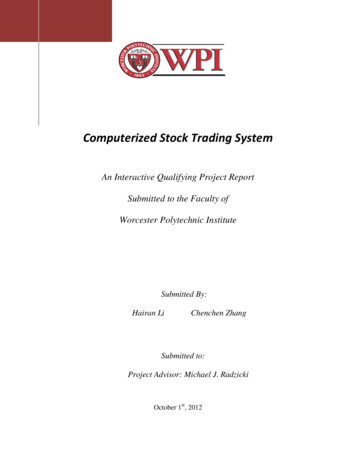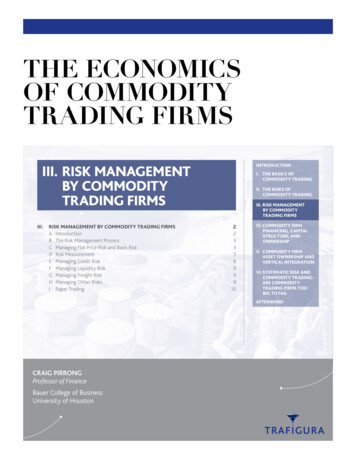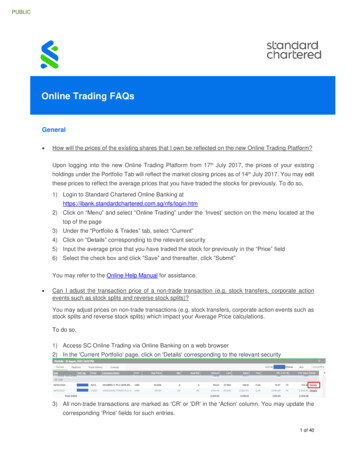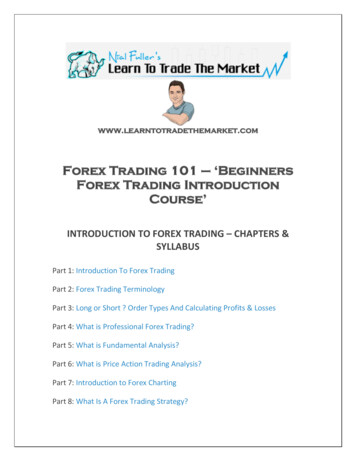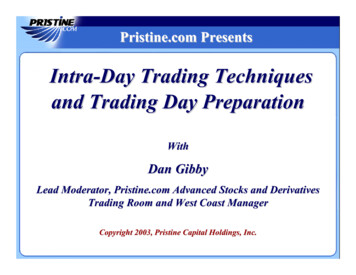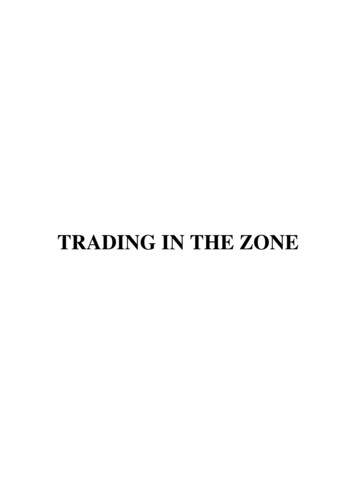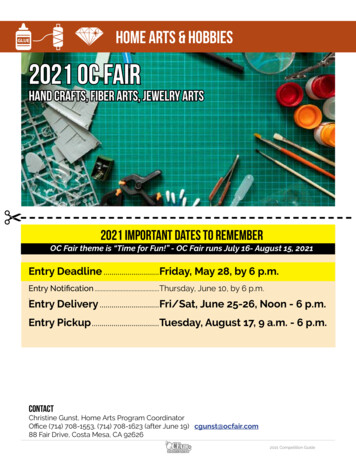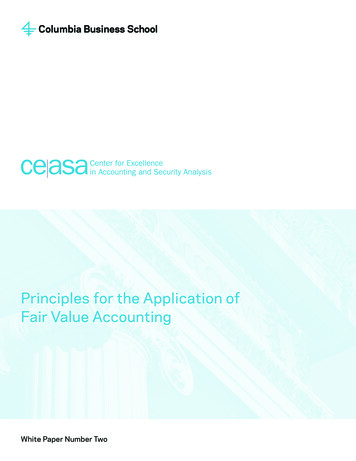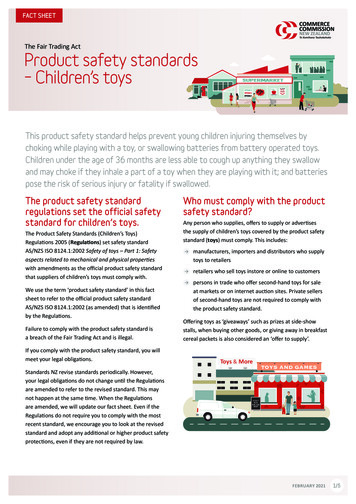
Transcription
FACT SHEETThe Fair Trading ActProduct safety standards– Children’s toysThis product safety standard helps prevent young children injuring themselves bychoking while playing with a toy, or swallowing batteries from battery operated toys.Children under the age of 36 months are less able to cough up anything they swallowand may choke if they inhale a part of a toy when they are playing with it; and batteriespose the risk of serious injury or fatality if swallowed.The product safety standardregulations set the official safetystandard for children’s toys.The Product Safety Standards (Children’s Toys)Regulations 2005 (Regulations) set safety standardAS/NZS ISO 8124.1:2002 Safety of toys – Part 1: Safetyaspects related to mechanical and physical propertieswith amendments as the official product safety standardthat suppliers of children’s toys must comply with.We use the term ‘product safety standard’ in this factsheet to refer to the official product safety standardAS/NZS ISO 8124.1:2002 (as amended) that is identifiedby the Regulations.Failure to comply with the product safety standard isa breach of the Fair Trading Act and is illegal.If you comply with the product safety standard, you willmeet your legal obligations.Standards NZ revise standards periodically. However,your legal obligations do not change until the Regulationsare amended to refer to the revised standard. This maynot happen at the same time. When the Regulationsare amended, we will update our fact sheet. Even if theRegulations do not require you to comply with the mostrecent standard, we encourage you to look at the revisedstandard and adopt any additional or higher product safetyprotections, even if they are not required by law.The Fair Trading ActProduct safety standards – Children’s toysWho must comply with the productsafety standard?Any person who supplies, offers to supply or advertisesthe supply of children’s toys covered by the product safetystandard (toys) must comply. This includes: manufacturers, importers and distributors who supplytoys to retailers retailers who sell toys instore or online to customers persons in trade who offer second-hand toys for saleat markets or on internet auction sites. Private sellersof second-hand toys are not required to comply withthe product safety standard.Offering toys as ‘giveaways’ such as prizes at side-showstalls, when buying other goods, or giving away in breakfastcereal packets is also considered an ‘offer to supply’.Toys & MoreTOYS AND GAMESVISITOURONLINESHOPFACT SHEETFEBRUARY2021FEBRUARY 20211/5
What types of toys are coveredby the product safety standard?What types of toys are excluded?A toy is defined in the Regulations as any object manufactured,designed, labelled, or marketed as a plaything for use inlearning or play by a child; and includes: balloons bicycles with a wheel base smaller than 640 mmThe Regulations exclude the following types of toys: books and other items made of paper rattles, dummies, teethers, squeeze toys cassette tapes, compact discs, DVDs, and records toys that come attached to a crib, stroller, play-penor baby carriage dummies and pacifiers (other than toy dummiesand toy pacifiers) push and pull toys, pounding toys, blocks andstacking toys paints, paint brushes, and other painting tools flotation aid toys for use in water toys for use in baths, wading pools and sand marbles rocking, spring and stick horses or other figures musical chime toys, jacks-in-the-boxmodelling materials including clay, plasticine,and playdough stuffed, plush or flocked animalsand similar articles games and puzzlesplayground equipment for parks, schools, anddomestic use – eg, swings, seesaws, slides,sand pits, sliding poles, and ladders dolls toy cars, trucks and other vehicles.toys made solely from porous material such ascheesecloth writing materials including crayons, chalk, pencils,and pens.The product safety standard applies to all toysmanufactured, designed, labelled, or marketed for use bychildren up to and including 36 months of age. This applieswhether or not the toys are also manufactured, designed,labelled, or marketed for use by children over that age.How can I tell if the toy is for useby children up to and including36 months of age?This has to be decided on a toy-by-toy basis. The test iswhether, viewed through the eyes of a reasonable personit can be said the toy in question was either manufactured,designed, labelled or marketing as a plaything for use bychildren up to three years?Unassembled toys, that when put together by an adultfollowing the supplied written instructions will meet therequirements of the product safety standard are also excluded.There are published guidelines that assist with determiningthe appropriate age at which children begin playing withcertain types of toys, including: Standards New Zealand: Technical Report on Safetyof Toys, SA/NZ TR ISO 8124:82016, Part 8: AgeDetermination Guidelines, Published 7 November 2016. Age Determination Guidelines: Relating Children’s agesto toy characteristics and play behaviour 2002: producedby the US Consumer Product Safety Commission.Ask yourself “does this toy have characteristics that makeit appealing for a child up to 36 months to play with?”For a general guide, if a child up to 36 months: is physically capable of using the toy as it isintended to be used is intellectually capable of using the toyas it is intended to be used is interested in playing with the toythen the toy is likely to be within the scope of theproduct safety standard.The Fair Trading ActProduct safety standards – Children’s toysFACT SHEETFEBRUARY 20212/5
Toys must not: be of a size and shape that creates a hazard ifswallowed, inhaled or placed in the mouth have small parts designed to be removed from the toythat will create a hazard if swallowed, inhaled or placedin the mouth have pieces that can break off during normal use orduring reasonably foreseeable abuse and that createa hazard if swallowed or inhaled.allow batteries to be accessible without the use of atool, or two independent movements that are carriedout simultaneously to open the battery compartmentallow the battery compartment to become accessibleif the toy is dropped.The product safety standard contains more detailedrequirements, some of which are very technical in nature.You should read the product safety standard to make sureyou understand all the requirements.How is normal use or foreseeableabuse of a toy tested?The product safety standard provides guidance on testingthe likely use or abuse a child will place on toys. This isto check that no part of the toy will come off that may bea potentially dangerous choking hazard.The tests are designed to simulate normal playing witha toy that: fits with the toy’s instructions for use has been established for that type of toyby tradition or custom is evident from the toy’s appearance.The ‘foreseeable abuse’ tests are designed to simulateconditions where abuse conditions could occur.For example, a child drops a toy when playing.The Fair Trading ActProduct safety standards – Children’s toysThe product safety standard provides information anddimensions to measure whether toys or toy parts aretoo small. If a toy, or a part of a toy, is smaller than thesedimensions, then it is too small and does not meet theproduct safety standard.Generally, any toy or part of a toy which fits entirely inthe ‘small parts cylinder’ will not meet the requirementsof the product safety standard (see diagram below).There are also minimum size and shape requirementsset out in the product safety standard, for specific typesof toys including: squeeze toys, rattles, teethers and teething toys legs of baby gyms (including removable parts) small balls pompoms preschool figures toy pacifiers.You should check the product safety standard for the specificrequirements for these types of toys.Small parts cylinder31.7mm57.1mmThe product safety standard specifies the acceptable criteriafor the structural characteristics of toys, and that anybatteries in a toy are not easily accessible. It sets out thetests to be carried out to determine whether a toy meetsthose requirements.What size of toy, or piece of toy,can create a choking hazard?25.4mmWhat are the safety requirements?ACTUAL SIZEFACT SHEETFEBRUARY 20213/5
Can I label a toy “Not suitable forchildren under 36 months of age”to avoid having to comply?What can happen if I sell a toy thatdoes not comply with the productsafety standard?No, if a toy has characteristics that appeal to a child upto 36 months, you cannot use a warning label to avoidcomplying with the product safety standard. For example,a baby’s rattle labelled ‘Not for children under 36 monthsof age’ must comply as it is designed for use by an infant.It is an offence under section 30 of the Fair Trading Act tosupply, offer to supply or advertise for supply a toy that doesnot comply with the product safety standard. The CommerceCommission, who enforces the Fair Trading Act, may take aprosecution against you in court.EXAMPLEUnsafe Baby Buggies and Baby RattlesAn importer was fined 65,000 for selling 1200 unitsof a toy baby buggy and baby rattle that did notcomply with the product safety standard. The toysfailed to comply with the standard and were unsafeas during testing small plastic fragments broke freefrom the buggy and rattle, creating a choking hazardfor children up to 36 moths of age.Who is responsible for making surethe toys I supply are safe?Although the manufacturer may carry out the required tests,distributors and retailers are also responsible for making surethe toys being offered for sale are safe.There can be serious consequences for businessesthat a court finds to have broken the law. Companiescan be fined up to 600,000 for each breach and anindividual up to 200,000. Where a company is arepeat offender, directors and those involved in themanagement of the company can be banned frominvolvement in the management of any company fora period of up to 10 years.In addition to any action taken by the CommerceCommission, you may have to conduct a recall of anytoys you have supplied which do not comply. Informationon carrying out a product recall is available from TradingStandards at the Ministry of Business, Innovation andEmployment. www.consumerprotection.govt.nzYou should not assume that toyscomply with the product safetystandard simply because a supplierhas offered to supply them to you.If you have any concern about thesafety of toys you have for sale, donot sell them. Confirm first withyour supplier that the toys comply with the product safetystandard. The best way to prove this is for your supplier toprovide you with a copy of independent test results. You canalso arrange your own testing.EXAMPLEUnsafe Baby RattleAn importer was fined 20,000 for selling 271 babyrattles that did not comply with the product safetystandard. When tested slivers of plastic broke fromthe rattle. Those slivers fitted inside the small partscylinder, and they therefore created a choking hazardfor children up to 36 months of age.The Fair Trading ActProduct safety standards – Children’s toysFACT SHEETFEBRUARY 20214/5
Are there any other relevant safetyrequirements for toys?Where can I get more informationabout the product safety standard?There are two “Unsafe Goods Notices” in force which relatedirectly to toys. These are:The standard AS/NZS (ISO 8124.1:2002) Safety of toys –Part 1: Safety aspects related to mechanical and physicalproperties is available for purchase from StandardsNew Zealand by calling 0800 733 656, or via its website:www.standards.co.nz Unsafe Goods (Lead in Children’s Toys) IndefiniteProhibition Notice 2009 – This declares children’s toyswhich contain more than a certain amount of lead inthem to be unsafe.Unsafe Goods (Small High Powered Magnets) IndefiniteProhibition Notice 2014 – This declares separable orloose magnets, which fit into the small parts cylinder(as above) and have a magnetic strength over a certainamount, to be unsafe.You can access the Regulations and the Fair TradingAct online at the government’s legislation websitewww.legislation.govt.nz. The information on thiswebsite is free.It is an offence under the Fair Trading Act 1986 to supply,or offer to supply, or advertise to supply goods whichhave been declared to be unsafe. More information aboutthese and other Unsafe Goods Notices can be found atwww.standards.co.nz.EXAMPLE123 Mart LimitedA low cost retailer was fined for selling approximately9,000 units of seven types of toys that did not complywith the product safety standard. The toys failed tocomply with the standard and were unsafe as theyhad small parts that presented choking hazards foryoung children, or parts which might break off duringreasonably foreseeable handling and become achoking hazard. The 123 Mart also sold 1,200 itemsof children’s sleeping pants, which did not havethe required fire danger labels and 11,000 itemsof clothing, which failed to comply with consumerinformation labelling requirements for care, origin andcontent. In total the company was fined 337,000.ISBN 978-1-869454-88-3Copyright in AS/NZS ISO 8124.1:2002 Safety of toys – Safety aspects related to mechanical and physical propertiesis owned by Standards Australia Limited and the Crown in right of New Zealand, administered by the New ZealandStandards Executive. Material from the standard has been reproduced with permission from Standards New Zealand,on behalf of the New Zealand Standards Executive, under copyright licence LN001290.This fact sheet provides guidance only. It is not intended to be definitive and should not be used in place of legaladvice. You are responsible for staying up to date with legislative changes.You can subscribe for information updates at www.comcom.govt.nz/subscribeContact us with information about possible breaches of the laws we enforce:Phone: 0800 943 600 Write: Enquiries Team, PO Box 2351, Wellington 6140The Fair Trading ActProduct safety standards – Children’s toysEmail: contact@comcom.govt.nzFACT SHEETFEBRUARY 20215/5
rattles, dummies, teethers, squeeze toys toys that come attached to a crib, stroller, play-pen or baby carriage push and pull toys, pounding toys, blocks and stacking toys toys for use in baths, wading pools and sand rocking, spring and stick horses or other figures musical chime toys, jacks-in-the-box




